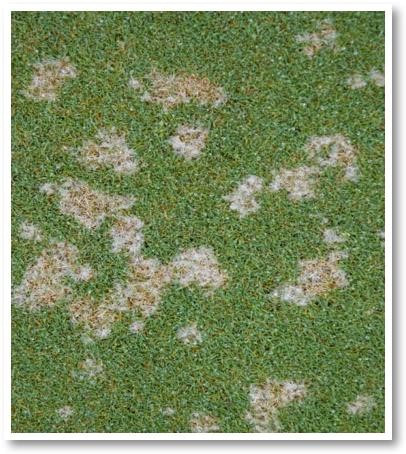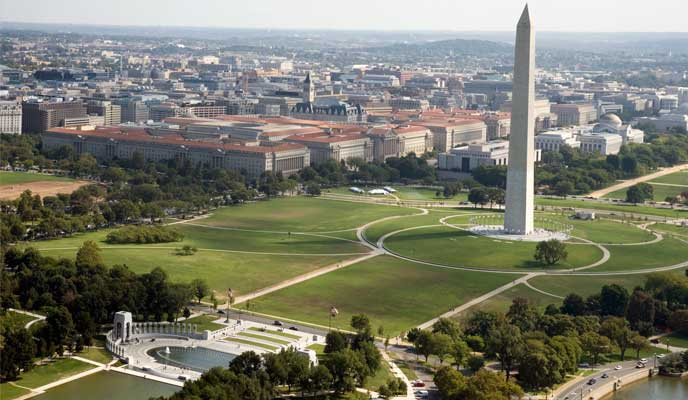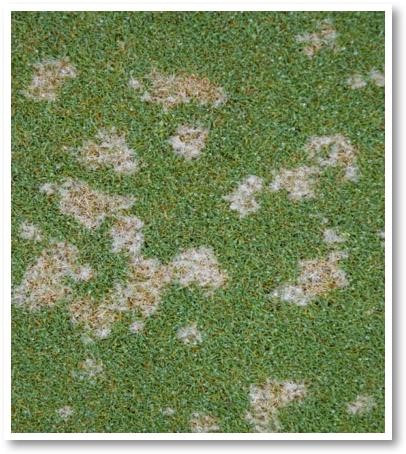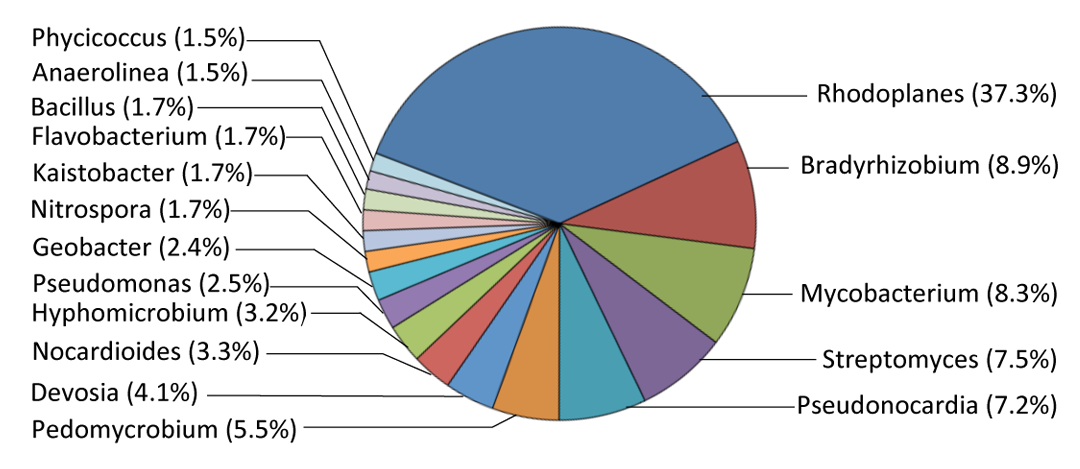 Figure 2: “Dollar spot” of turf grass caused by Sclerotinia homoeocarpa. Photo Credit: Dr. Joseph Roberts Figure 2: “Dollar spot” of turf grass caused by Sclerotinia homoeocarpa. Photo Credit: Dr. Joseph Roberts Turfgrass landscapes are a major component of our beloved parks, sports fields, golf courses, and historical monuments. Dr. Joesph Roberts, an assistant professor at the University of Maryland, is currently investigating the microbial communities present on the turfgrass of the National Mall in Washington D.C.. Dr. Roberts' research is fighting to keep our beautiful landscapes looking like the "American dream" and not like an American wasteland.  Figure 1: The National Mall, Washington Monument, and World War II Memorial. Photo credit: Carol Highsmith Figure 1: The National Mall, Washington Monument, and World War II Memorial. Photo credit: Carol Highsmith When most of us look out over our front lawns, we see green blades of grass rising from the earth, but usually nothing more. Look through the eyes of Dr. Joseph Roberts and you’ll see a different story: our supposedly mundane grasses are actually home to a wide variety of microscopic organisms. Most of the time, these organisms are hardly any cause for concern, but if your grasses harbored one of the pathogenic, or disease-causing strains of fungi, your idyllic front lawn might look more like an American wasteland than the American dream. Over the past decade, Dr. Roberts has been hard at work to save our nation’s most beloved landscapes. More recently, he has explored turf microbes at the National Mall, commonly known as our nation’s very own front lawn. Dr. Roberts is an assistant professor in the Department of Plant Science and Landscape Architecture at the University of Maryland who studies the infectious bacteria and fungi that ruin the aesthetic of any turf environment. His research influences the management decisions that keep our parks, sports fields, and golf courses functional and pleasing to the eye.  Figure 2: “Dollar spot” of turf grass caused by Sclerotinia homoeocarpa. Photo Credit: Dr. Joseph Roberts Figure 2: “Dollar spot” of turf grass caused by Sclerotinia homoeocarpa. Photo Credit: Dr. Joseph Roberts Preventing turfgrass diseases has always been a responsibility delegated to land managers across the nation. Essentially, wherever there is turfgrass, pathogens for these grasses are also present. For most of the history of turf management, the majority of turfgrass diseases that these land managers have encountered have been fungal diseases, which are more readily handled by fungicidal spraying programs. However, in the past 10 years, bacterial diseases have become more prevalent and difficult to treat, particularly on highly managed golf courses. Bacterial issues leave turf managers scrambling for curative measures and treatments to counter the spread of these diseases. These bacterial pathogens can cause turf landscapes to appear patchy or that the grass is dying, a condition known as “bacterial wilt”. Seeing the rise of bacterial issues in managed turfgrass systems, Dr. Roberts began studying turfgrass microbiomes. Due to the lack of previous research, little was known about the species that make up the microbial communities inhabiting turfgrass or what factors shape the composition of these communities. This lack of information led Dr. Roberts to form a regional study group dedicated to learning more about what he calls the “phytobiome”, or the system of factors that influence or are influenced by turfgrass management. For Dr. Roberts’ research, this meant learning where bacterial communities are found on turfgrass and how environmental factors might influence these communities. Luckily for Dr. Roberts, recent renovations to restore the National Mall in Washington D.C. gave him a perfect opportunity to test some of his ideas.  Figure 3: The total genera of bacteria observed in the National Mall turf grass and their community densities. Pre- and post-renovation samples were similar to one another, presenting similar communities and densities. Image Credit: Crouch et al. 2017 Figure 3: The total genera of bacteria observed in the National Mall turf grass and their community densities. Pre- and post-renovation samples were similar to one another, presenting similar communities and densities. Image Credit: Crouch et al. 2017 To see how the environment affects microbial turfgrass communities, Dr. Roberts took plant and soil samples from non-renovated turfgrass from the National Mall in 2015, post-renovation turfgrass later that year, and replicate samples from a turf field at another site hundreds of miles away in New Jersey. After identifying the communities present in these samples to genus, Dr. Roberts identified a diverse set of bacteria. Dr. Roberts’ studies also found that the bacterial communities between all sites studied were very similar. These results support the idea that regional temperatures and climate may have more of an impact on these bacterial communities than other localized environmental influences. Dr. Roberts had also found that certain bacteria make their home on different areas on the grass, such as on grass seeds, which could allow for more precise control of potentially pathogenic strains. Dr. Roberts’ findings that microbial communities in turfgrass are regionally similar and changed most by temperature will allow turf managers to better understand what bacterial pathogens could potentially be lurking in their landscapes, leading to the creation of more effective management strategies to prevent turfgrass disease. Dr. Roberts’ research into what factors promote potentially pathogenic bacteria are ongoing. In the future, Dr. Roberts will continue the fight to save our nation’s beautiful parks and landmarks by further investigating the nature of the turf phytobiome. References: Crouch, J. A., Z. Carter, A. Ismaiel, and J. A. Roberts. 2017. The US National Mall Microbiome: A Census of Rhizosphere Bacteria Inhabiting Landscape Turf. Crop Sci. 57(Suppl1):S-341-S-348. doi:10.2135/cropsci2016.10.0849 About the author: Dylan Kutz is a MSc student in the Lamp Lab at the University of Maryland, where he is studying natural enemy habitats in agroecosystems. He is currently working on a project assessing the value of agricultural drainage ditches as refugia for natural enemies of agricultural pests. Comments are closed.
|
Categories
All
Archives
June 2024
|
Department of Entomology
University of Maryland
4112 Plant Sciences Building
College Park, MD 20742-4454
USA
Telephone: 301.405.3911
Fax: 301.314.9290
University of Maryland
4112 Plant Sciences Building
College Park, MD 20742-4454
USA
Telephone: 301.405.3911
Fax: 301.314.9290

 RSS Feed
RSS Feed




